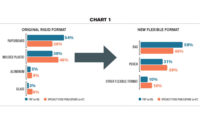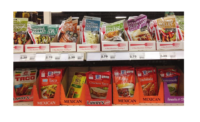
Q: In a nutshell, explain flexible film converting.
Beuning: The different converting operations – printing, laminating, pouching, coating, and others – have differing film performance requirements. Gauge, treat levels, clarity, film flatness, sealability and film uniformity are just a few of the properties that a converter will find critical to their process or end use.
It is imperative that film manufacturers know end-use requirements and to have the process controls and checks in place to deliver films that meet or exceed these requirements. Charter NEX Films, Inc., works closely with our customers to understand their converting processes and specifications, allowing us to customize a film to meet their needs.
Crimmin: Flexible film converting can take on many different forms and applications. That’s what makes this market so interesting. End-uses range from bread bags to tapes to sophisticated laminations for food products. RKW Danafilms provides films, both monolayer and coextruded, for a wide assortment of markets and customers.
These films can be made into bags, coated with various adhesives and materials and laminated to other products such as PET films, PP films, paper and nonwovens. The films provide specific properties such as moisture barrier, strength, oxygen barrier, stiffness, softness and sealability.
The end-use and the requirements of the film determine what the composition will be. Specific resins have specific properties, and when put together, can result in an outstanding multifunctional package. By multifunctional, I mean a package that protects the product, looks good from a consumer standpoint and can provide cost savings.
Flexible packaging is truly a market of creativity with a wide assortment of films and substrates available to make an attractive functional package which uses less material and reduces the impact on the environment.
Q: What kinds of flexible packaging converted films do you offer?
Crimmin: RKW Danafilms produces a wide variety of custom polyethylene films used in the flexible packaging converted films market. Films are produced in a monolayer structure or a coextruded structure (up to 7 layers). What determines the film make-up depends entirely upon the requirements of the end-use packaging. These films provide a variety of functions which range from strength to sealability to barrier.
Monolayer films are made up of a variety of polyethylenes such as LDPE, LLDPE, HDPE, mLLDPE and EVA. These components are blended together in the extruder to create a film that will serve several functions. The most common request is for a film that will be strong and seal quickly. This allows the end-user to provide a package that can be filled fast and provide adequate protection for the product.
RKW Danafilms’ coextruded-product slate has a wide range of offerings. Coextruded films use advanced film technology to take the feeds from more than one extruder and combine these feeds in the die in a layered technology so the benefits of each resin can be maximized. One example is a three layer coextruded film used in cereal liners. The layers provide two different functions: HDPE in one layer provides stiffness and barrier while the EVA layer provides a good sealant which can increase line speed. Another example is a film used for food packaging where a good oxygen barrier is required. The EVOH layer provides the oxygen barrier while the other layers provide strength and good sealability.
A majority of these films are laminated to other substrates such as PET, PP and paper. The end result is a film which can provide several functions. In a number of situations a coextruded film can replace a lamination step saving cost at the same time.
Beuning: Charter NEX Films, Inc., offers a variety of mono and multilayer coextruded films for several markets. These films may be composed of LDPE, LLDPE, mPE, EVA, EVOH, nylon or various specialty resins. Our largest market segment is converter grade films for the food and beverage market. In this market, our customers are concerned with properties such as optics, organoleptics, film toughness and sealability, among others. We customize each film grade to meet end use specifications. We also have some specialty grades such as peelables, medical and microwaveable reheat or cook-in films. Each film we produce can be optimized for the end-use and our film quality is ensured by several controls, such as our resin blending and on-line gauging systems.
Q: Which is your most popular flexible film? In what applications is this film typically used?
Beuning: Charter NEX Films has several grades of general and high performance sealant films. Our converter grade film family allows for greater optimization of film properties allowing for adjustment to seal properties and film performance. Our SuperC family of films includes more economical grades that allow for film performance adjustment, but maintain a common sealant. These films are typically utilized in multilayer laminations for a wide variety of applications, from food & beverage to health & beauty to medical. We also produce many customized film grades for each customer's specific application to optimize efficiencies of converting equipment as well as end use performance.
Q: Which is your most popular flexible film? In what applications is this film typically used?
Crimmin: Coextruded films are definitely gaining in popularity. The ability to eliminate steps and provide cost savings never loses its appeal. RKW Danafilms Evoseal and Resiliseal films continue to grow in demand for their functionality and cost effectiveness.
Evoseal has several different films in the EVOH family, each of which takes the primary function of oxygen barrier and combines it with a function specific to an end use. X5537 is the general-purpose film used for a wide variety of applications ranging from packaging nuts and dried fruit to specialty pet foods. X5574 adds a stiffness component to the barrier function allowing for down gauging possibilities.
This film is particularly popular in packages such as SUPs (stand-up pouches)where stiffness is required. X5575 provides barrier with the capability to seal to Polypropylene. Each of these films is typically laminated to PET or PP films. Resiliseal is a nylon-based family of coextruded films which provide toughness, chemical and heat resistance along with excellent sealing properties.
These films are used in packaging chemicals, hot food products and lawn care products.
X5651 is an excellent film for packaging products which contain chemicals such as detergents, lawn care products and industrial products. The combination of excellent chemical resistance and good sealabilty allows the customer to provide a safe package for a potentially harmful product.
For applications which require the packaging of hot food products during filling, X5643 is an excellent choice. Heat resistance is a must to prevent the hot food from deforming the package. Another major requirement is the ability to create a seal through potential food contamination in the seal area.
In both cases, the films perform several functions which a monolayer film cannot do. This provides potential cost savings to our customers by the elimination of additional processing steps.
Q: What is your most versatile flexible film? In what applications is this film typically used?
Beuning: Our converter grades would be our most versatile film family and highest volume films. These films are customized for Strength, Stiffness, Optics or Economics and allow for specialized sealant layers, depending upon the end-use. The sealants available range from LLDPE to metallocene grades to specialized resins.
Each film is optimized for individual customer applications, taking end-use performance and machineability into consideration. Because this family of films is so versatile, these films work for a wide variety of applications. Our converter grade family of films has been used to package products for the following markets: food and beverage, lawn and garden, pet food, health & beauty, medical, personal care and many others.
Q: What’s missing from this sector? What would you like to see improve?
Crimmin: The flexible packaging industry needs to increase its self-promotion. There are tremendous advances being made in materials which provide better packaging with a reduced amount of materials offering cost savings both through fewer processes and lower freight costs.
These seem to get lost in the public’s perception of our industry. The flexible packaging industry needs to mount an aggressive campaign promoting its benefits to offset the views presented by competing industries. Their strategy is, "The best defense is a good offense."
We need to point out the shortfalls of our competitors and the advantages flexible packaging has to make lives simpler, more efficient while lowering the cost.
Brian Beuning
Senior VP of Sales and Marketing
Charter NEX Films
8 years with the company
www.charternex.com
Steve Crimmin
U.S. Director of Sales and Marketing
RKW Danafilms
21 years with the company
www.danafilms.com



